What Is Nyonya Food? A Journey Through Flavor, Family, and Forgotten Histories
At the table with Baba Jay and Poh Wan, we explore a culinary tradition that fuses Chinese roots with Malay spices—and survives through stories.
Just off Jalan Gurdwara in Georgetown, Penang, you will find a row of preserved shophouses with an ornate exterior; intricately molded arches, shutters with gilded carvings, and hand-painted tiles. This is a common type of architecture found in Penang, with the ground floor functioning as a store, and the top floor providing the living space. Today, many of them have been converted entirely into homes, hotels, and even restaurants1. In the early evening, the local street is quiet; guests of nearby boutique hotels have likely stepped out of the night. However, by following inconspicuous signage you can find a dining experience known as Little Kitchen @ Nyonya (referred to onwards as Little Kitchen).
Arriving at the venue and milling around the front of the home, unsure of where exactly we should be, a staff member emerges to show us through the turquoise side gate of the property, through a small enclosed courtyard, and then into the home through a side door. The home, which has been in the host's family for generations, is typical of the Peranakan ‘shophouse’ architecture seen across Penang, Malacca, and Singapore. The first room, acting as a foyer, is museum-like - filled with dark, wooden furniture with carved floral detailing and metallic tone accents. Turning into the dining room, we are greeted by the host, who calls himself ‘Baba Jay,’ in a warmly lit interior. The warm lighting is complemented by a tiled wainscot bordering the room in a shade of butter yellow, accented by a green trim and floral motifs. A collection of photographs and memorabilia in the same dark, wood frames cover the walls, filled with images and artifacts of the past, family portraits, and paintings.
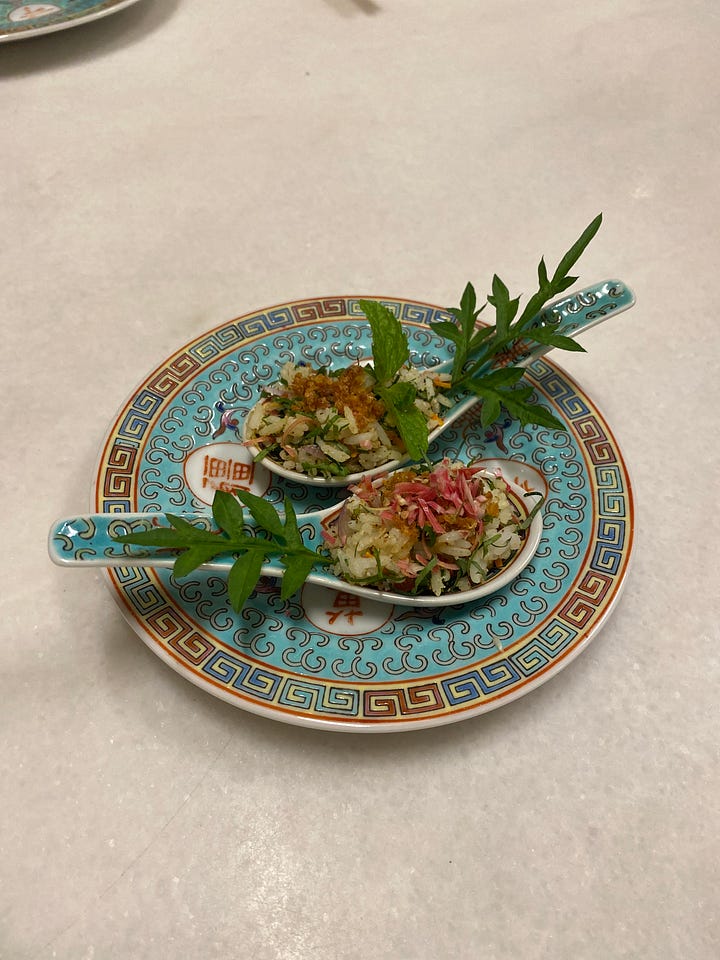
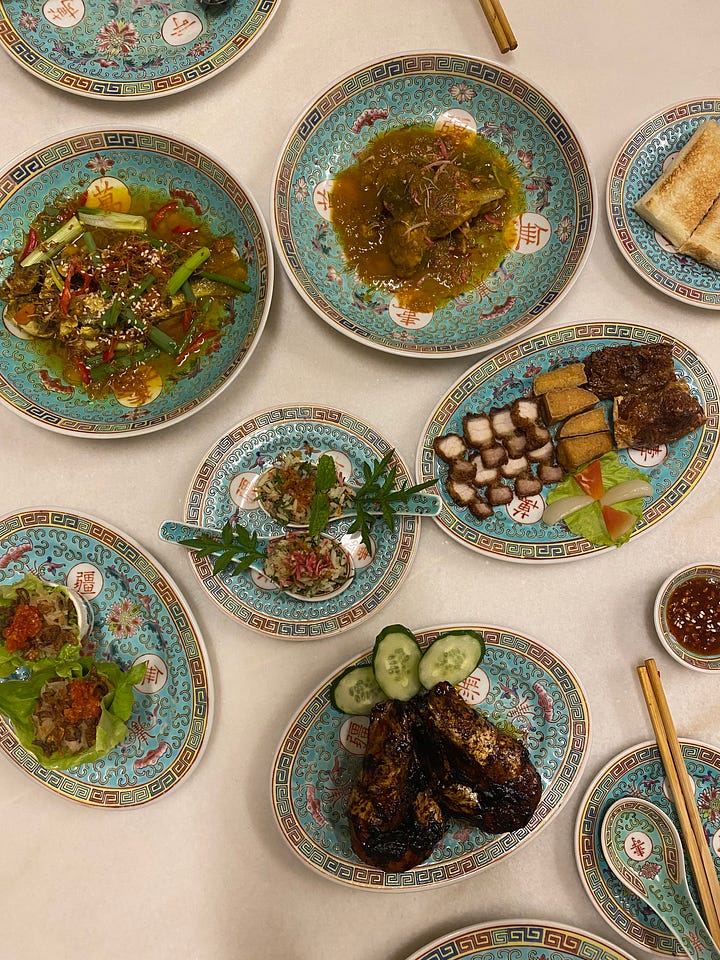
Little Kitchen is not your typical restaurant - it is reservation only, which can be done via Instagram DM or telephone, and there is no menu. Instead, you are served a multi-course selection of food from Baba Jay’s family recipes. With the introduction of each course, Baba Jay takes care to spend time with each table, explaining the origins and influences of each dish, and making use of visual aids he has collated into a booklet. The diners are invited to take part in preparing one dish in particular, nasi ulam. A table in the centre of the dining room is equipped with cutting boards, knives, and all one would need to create their mise en place.
Baba Jay instructs us to slice torch ginger and kaffir lime leaf into razor thin threads for addition into a mix of dried shrimp and toasted coconut. The result is an incredibly fragrant and colorful mix of rice and aromatics, which, in a single bite, is extraordinarily herbal, vibrant, and umami. Other dishes include kari kapitan, a chicken curry flavored with turmeric and lemongrass, and a selection of nyonya kuih, referring to a category of sweets generally made with glutinous rice and a mix of other ingredients like pandan, coconut, and palm sugar.
The experience is a delightful contradiction; the setting is extremely intimate given the limited seatings offered (there were only two seated tables at the time of my visit) and the elegance of the serving ware, yet Baba Jay’s casual demeanor and witty conversation makes one instantly feel comfortable. During the sitting he plays his favorite music - Lost in Paradise by Joanna Wang.
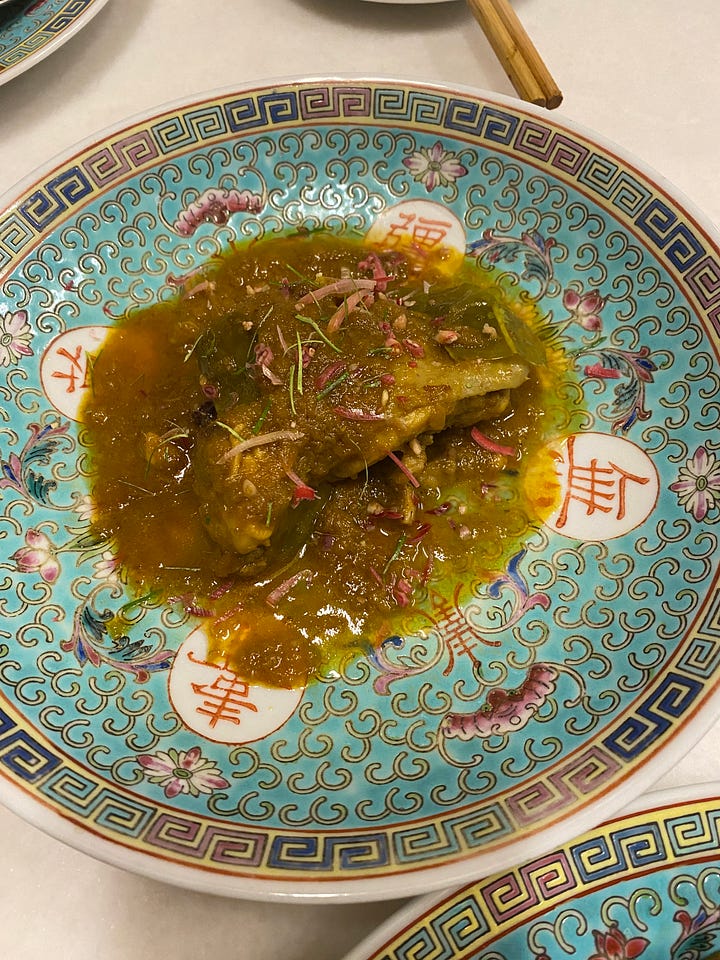
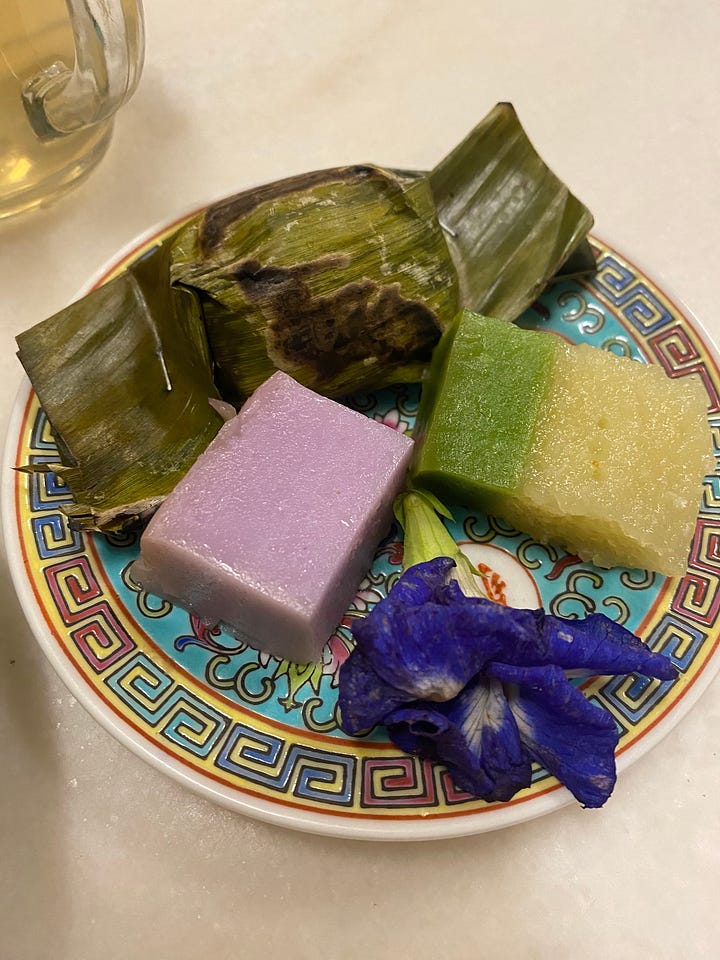
The dishes served at Little Kitchen have a common origin, which can be traced to the Peranakan people. The Peranakan people - also known as ‘Baba’ and ‘Nyonya’ meaning man and woman, respectively - are the descendants of migrants from China to the Malay Peninsula between the 15th and 17th centuries2. The designation of Peranakan Chinese does not only fall to those who settled in the Malay Peninsula, but also across other parts of South East Asia3. This article focuses primarily on the history of those in Malaysia, specifically Penang.
Typically attracted to Penang and other Straits Settlements by economic prospects (referring to the British colonies which were established on the east coast of the Malay Peninsula - Penang, Labuan, Malacca and Singapore), the diverse influences of the Penang Peranakan are evident in both their language and cuisine. Penang Hokkien is a fusion of the Malay and Hokkien languages which were historically spoken by this population, and still are today - albeit to a lesser degree, as dialects continue to lose their foothold across the Chinese diaspora4.
I was first acquainted with this culture by my mother-in-law, Poh Wan. Now residing in South Sydney, she was born in Kuala Lumpur (KL) in 1965, and was raised in Kampung Attap - a neighbourhood in central KL, just south of Chinatown. Her grandparents migrated to Kuala Lumpur from Penang in the early 20th century to seek employment opportunities, but she recalls being aware of her Peranakan ancestry due to her grandfather’s attire, and the fact that their vernacular featured both Hokkien and Malay words: “my grandfather [would] use a little bit of Malay [and] no matter where he [went] he always [wore a] sarong.”
After the family’s move to KL, however, she believes that their connection to Peranakan culture diminished over time, mostly due to the predominance of Chinese culture in their neighbourhood. Sitting at her dining room table, sipping green orange and Pu’er tea, I asked her if there was a particular reason for the waning of Peranakan influence on her upbringing. “In KL there are not many [Peranakans]… eventually they [phase out] the culture”, she says, referring to the fact that her parents did not take after her grandparents, preferring to speak Hokkien or Cantonese only. Considering this, she says, “sometimes when you are the minority in the majority… in order for you to get business, to work, you need to be like them too”.
The Peranakan cuisine is also varied, with influences from Chinese, Malay, Indian, Thai, and even British cooking. It developed out of necessity, as Chinese migrants learnt to work with what was available in their new environment. Poh Wan reflected on this:
“[The] Chinese that migrated to Malaysia, brought their own stuff with them, but when they arrived… they found that there were so many things they [did not have in China]. So they [said], ‘Oh, there are so many coconut trees - maybe I can make use of the coconut tree’. They found that there were lots of spices and types of herbs, so they [made something from] their own imaginations… a little bit of coconut, a bit of spices”– resulting in the mix of cultures that is Peranakan cuisine.
Assam laksa, a popular dish found in Penang, is an example of this. Starkly different from the more commonly known curry laksa/curry mee found in the nation’s capital, assam laksa is marked by a punchy, sweet and sour flavour, with inclusions of tamarind, galangal and pineapple5. In recollection, Poh Wan speaks about some of the typical dishes she would enjoy with her family as a child, such as salted vegetable and duck soup or kiam chye ark, chicken curry, and stir-fried vegetables. Peranakan food is known for its use of aromatic and pungent flavours, such as a deeply-coloured paste of chilli and fermented shrimp called sambal belachan. “My father used to tell me his [uncle] made the best sambal belacan”, says Poh Wan.
Peranakan cuisine is known for its’ laborious preparation methods; from painstakingly grinding spices to a paste or rempah, or picking out only the most perfect candlenuts for a particular dish6. This exertion displayed in their method of cooking is reflective of the cultural and economic context of the time. The Peranakan Chinese (in Penang and elsewhere) historically adhered to patriarchal values, hence the skill displayed by women through preparing food was heavily linked to their perceived value7, as explained by Lee Su Kim;
“A Nyonya’s cooking ability could be assessed in the old days from the rhythm of the way she pounded the rempah to make sambal belachan”8.
Poh Wan mentions her mother using a similar technique with a mortar made of hard granite. Fittingly, the cuisine is known widely today as ‘Nyonya food’.
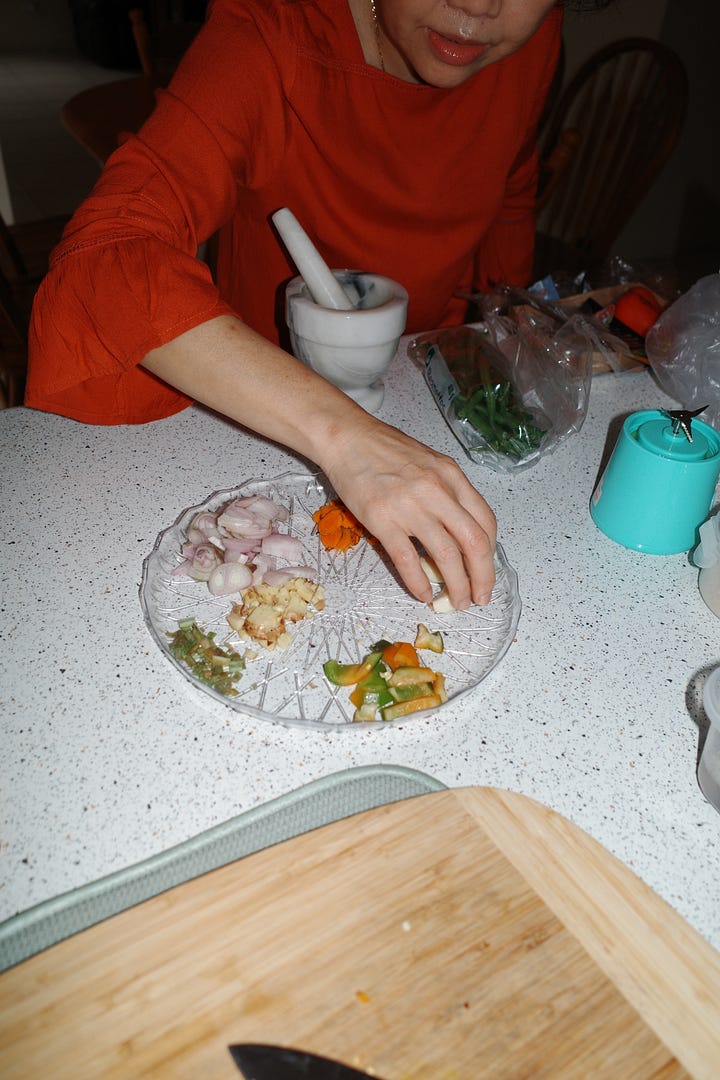
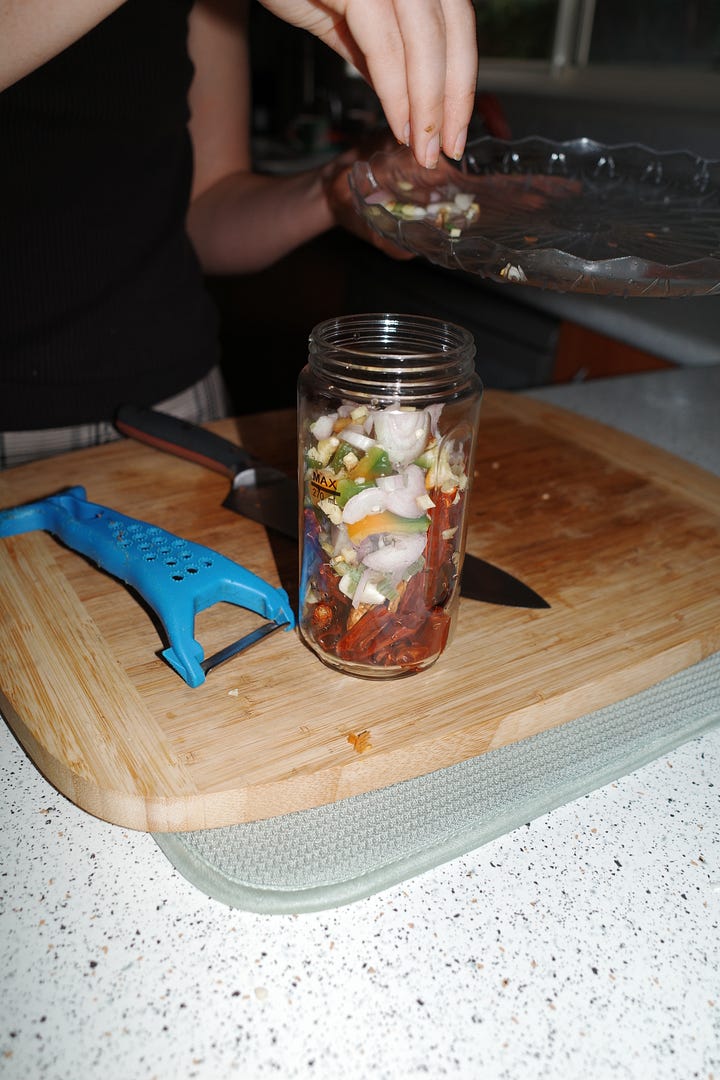
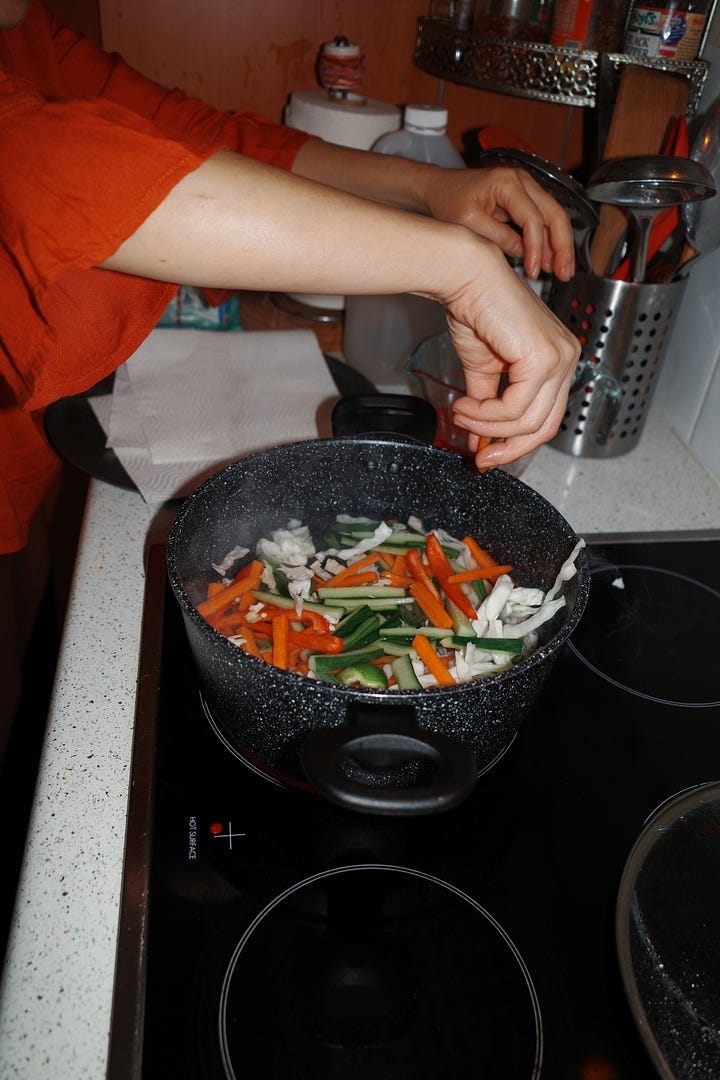
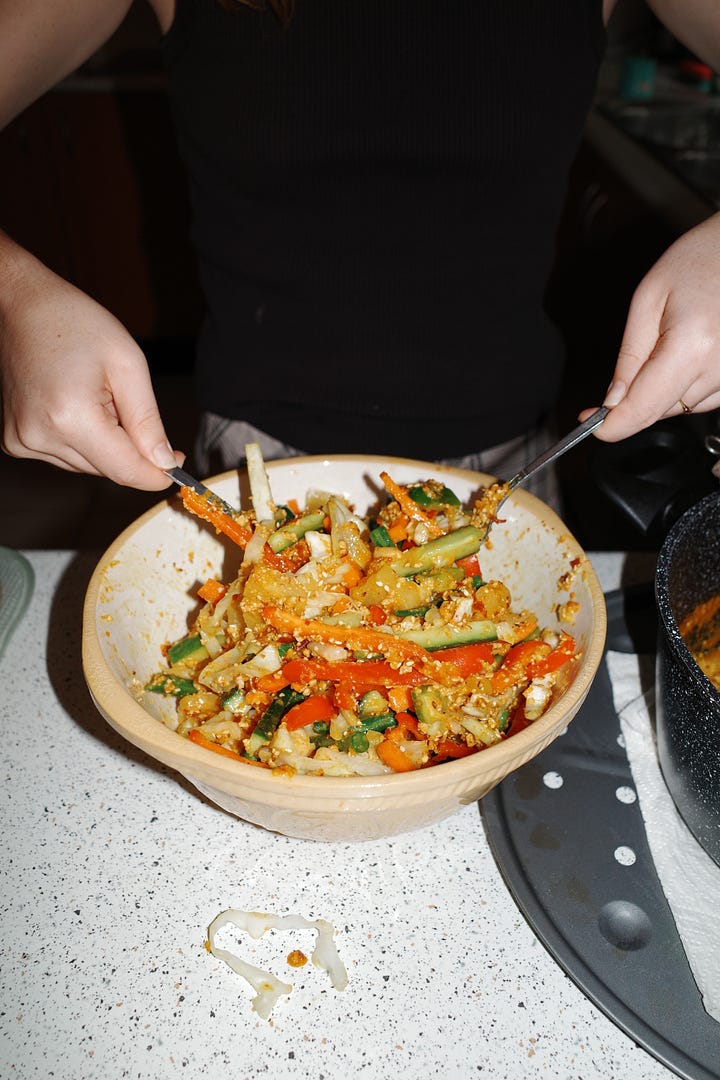
The dish achar is an intersection of cultures, from the techniques involved to the ingredients used. The dish itself is seen across South East Asia in different forms - from the atchara of the Philippines to acar in Indonesia. The nyonya achar is distinctive for its use of pineapple, roasted peanuts, and sesame, creating a sweet, vinegary, nutty, and ultimately addictive side to any meal. It was a dish prepared on special occasions for Poh Wan and her family, like Chinese New Year, and eaten as an appetiser. I had the privilege of preparing this dish under her instruction recently, which involved slicing vegetables into neat strips and preparing a paste of shallot, garlic, ginger, turmeric, lemongrass, and dried chili. Usually one would also include belachan (fermented shrimp paste) in the paste, however, we prepared a vegetarian version on this day to accommodate the dietary needs of the family. Walking me through each step of the dish, Poh Wan was mindful to facilitate experimentation, encouraging me to use my own judgement and taste when deciding how much of something to add, or how to slice a particular ingredient.
Once these components were prepared, the vegetables were blanched briefly, “to kill all the germs”, and the paste was fried in a neutral oil, adding vinegar and sugar once the paste had reduced slightly. Everything was done according to taste and appearance - as Poh Wan says, “we need to agak agak, which means to guess our cooking.” We toasted sesame seeds and crushed peanuts until golden and fragrant as the oils were released, bringing everything together for assembly. Mixing the vegetables, paste, and nuts together, it became clear to me why it should be served in celebration; like confetti, it was bright and colourful when tossed in the air.
To go alongside the achar, Poh Wan had prepared a few accompaniments which built the foundation of a simple nasi lemak - a popular Malay dish of coconut and pandan infused rice, served with accompaniments. In its most simple form, this includes sambal belachan, fried anchovies and peanuts, cucumber, and a boiled egg. Instead of coconut rice, she had steamed rice with cloves, cinnamon, and star anise, and had bought a caramelised onion sambal in place of the traditional sambal belachan. To our amusement, she had also had my father-in-law pick up some KFC fried chicken to pair with the meal, for omnivores like myself at the table. Unsurprisingly, the fried chicken, aromatic rice, and lightly pickled vegetables from the achar were a magical combination of sweet, sour, salty, and umami, with the sambal bringing a satisfying hit of spice.
Similar to what I experienced with Baba Jay, Poh Wan expresses pride in sharing her recipe, but more so humble satisfaction in observing our enjoyment. Sharing recipes allows them to hold onto memories, even as people grow old, pass on, or move across continents. At the conclusion of our conversation, Poh Wan portrayed a degree of melancholy both through words and countenance; this act of recollecting the past called attention to the many things she could not remember. As a member of her family, I feel a strong sense of responsibility in acknowledging this ancestry and finding ways to build fragments of it within my own life, and that which I share with my partner. Even with something as simple as learning to make achar, one can build cultural dexterity which can’t be easily taken away.
Reflecting on the state of Peranakan culture in Malaysia today, it is observable how Peranakans have made their mark on the national identity, most saliently through food - Laksa, one of Malaysia’s most recognisable dishes, would not be what it is today without Peranakan influence. Their distinctive identity, however, has significantly declined over time due to the modernisation of Malaysian society - traditional dress and methods of preparing food have largely gone out of fashion with younger generations. It should also be acknowledged that the prevalence of “ethnic demarcation”9 in Malaysia has reduced the attractiveness of a multicultural identity for the Peranakan. Shaqil Aqil touches on this:
“The Babas and Nyonyas are a sociological phenomenon that occurred because of British colonization… With the passing of the colonial regime, the Babas were left feeling isolated, unable to represent themselves as fully Chinese for numerous cultural and linguistic reasons and yet, not able to be assimilated into Malay culture, since religion was a barrier.”10
This notion is reminiscent of the experience of Poh Wan’s family, finding themselves wanting to fit in with the predominantly Chinese community in Kampung Attap.
As tourism tends to glorify Peranakan culture in Penang and Malacca (tourists can even pay to rent a traditional garment, the Nyonya Kebaya, and pose for staged photography, not unlike what is seen in Japan with the Kimono), these perceptions don’t necessarily reflect the truth. The carefully curated images of Peranakan life seen in tourist attractions offer a window into a specific set of socio-cultural circumstances which were facilitated under the British colonial empire, but do not reflect the current lifestyle of many descendants. Representations of the Baba and Nyonya may waver over time, but what remains true is a story of a people who, despite changing circumstances, continue to make use of and be inspired by new surroundings.
This piece was written by
. Living in Sydney, Australia, Chloe spends her weekend gardening and making sourdough bread.https://theslowroad.org/shophouses-of-penang/
https://journalofethnicfoods.biomedcentral.com/articles/10.1186/s42779-019-0010-x
https://books.google.com.au/books?hl=en&lr=&id=oJNfEAAAQBAJ&oi=fnd&pg=PR5&dq=peranakan+history&ots=TqJPdSw2Cf&sig=v5a09Vc7e5mHjcX9avW4-S36kfA#v=onepage&q=peranakan%20history&f=false
https://newnaratif.com/penang-hokkien-and-its-struggle-for-survival/
https://thebigissue.org.au/article/asam-penang-laksa-by-poh-ling-yeow/
https://www.tatlerasia.com/dining/food/why-peranakan-food-is-not-easy-to-cook
https://www.sciencedirect.com/science/article/pii/S2352618116300427?via%3Dihub#sec2
https://journalarticle.ukm.my/1125/1/The_Peranakan_Baba_Nyonya_Culture.pdf
https://www.academia.edu/1092322/Discourse_on_Peranakanness_with_focus_on_the_Peranakan_Chinese_community_in_contemporary_Kelantan_Malaysia
https://www.academia.edu/11063249/The_Peranakan_Baba_Nyonya_Culture_Resurgence_or_Disappearance
Funny Table is an independent food publication and video channel teaching you more about what you eat. We’re a small volunteer team committed to telling stories that reflect the diverse voices, cultures, and communities that shape what’s on our plates. Every share, comment, like, and subscription helps us keep going.
Liked this piece? Let us know your thoughts!
Enjoy educational media and stories about food? Check out our videos on YouTube and Instagram for more.






love this topic!! i have always wanted to read about nyonya food!